Airgas Plant Explosion: Safety Measures and Incident Report Analysis
VerifiedAdded on 2022/09/01
|15
|1344
|29
Report
AI Summary
This report examines the 2016 Airgas plant explosion in Florida, caused by the overheating of a pump transferring nitrous oxide. The incident resulted in a worker's death and injuries, leading to penalties from OSHA. The report details the incident, its impact on employee health, and safety measures, including labeling guidelines and DOT regulations for hazardous substances. It also covers the environmental and health effects of nitrous oxide, the CSB's recommendations, and the company's response. The analysis highlights the lack of proper safety management, failure of interlocks, and potential contributing factors like the use of steel wool in the filtration strainer. The report emphasizes the importance of proper safety protocols and equipment to prevent similar incidents in the future.
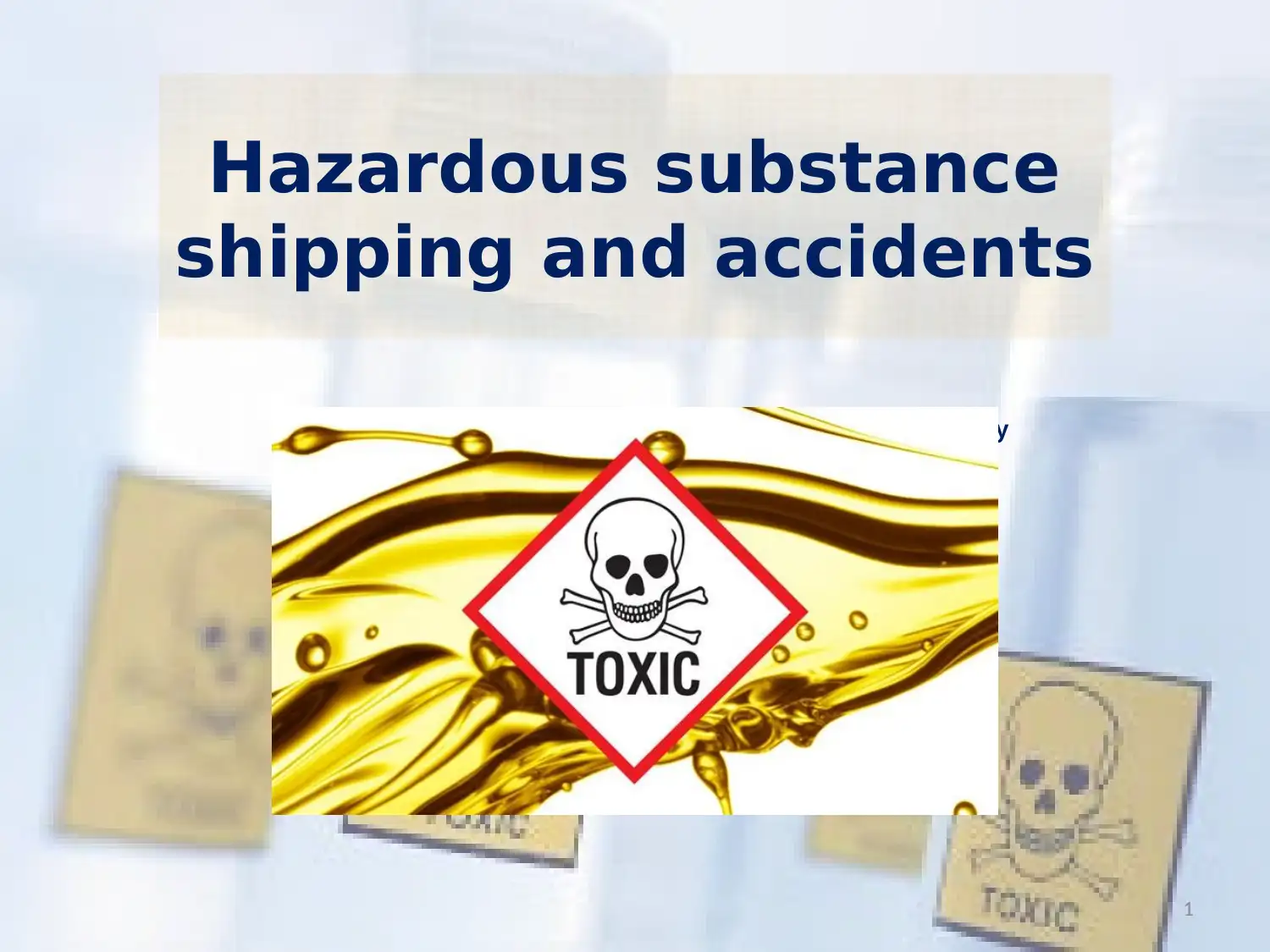
1
Hazardous substance
shipping and accidents
Courts and their views on public policing, private security
Hazardous substance
shipping and accidents
Courts and their views on public policing, private security
Paraphrase This Document
Need a fresh take? Get an instant paraphrase of this document with our AI Paraphraser
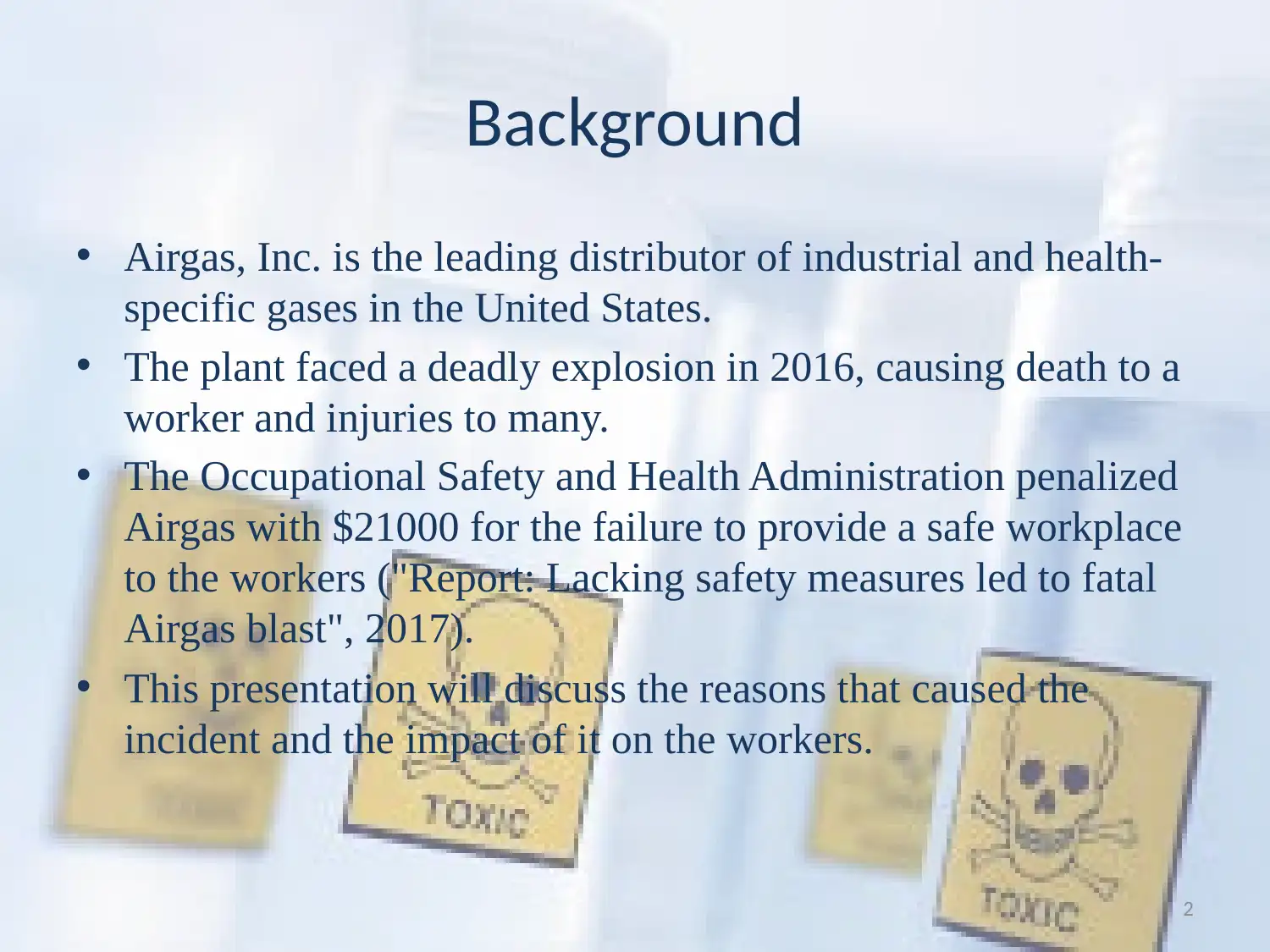
2
Background
• Airgas, Inc. is the leading distributor of industrial and health-
specific gases in the United States.
• The plant faced a deadly explosion in 2016, causing death to a
worker and injuries to many.
• The Occupational Safety and Health Administration penalized
Airgas with $21000 for the failure to provide a safe workplace
to the workers ("Report: Lacking safety measures led to fatal
Airgas blast", 2017).
• This presentation will discuss the reasons that caused the
incident and the impact of it on the workers.
Background
• Airgas, Inc. is the leading distributor of industrial and health-
specific gases in the United States.
• The plant faced a deadly explosion in 2016, causing death to a
worker and injuries to many.
• The Occupational Safety and Health Administration penalized
Airgas with $21000 for the failure to provide a safe workplace
to the workers ("Report: Lacking safety measures led to fatal
Airgas blast", 2017).
• This presentation will discuss the reasons that caused the
incident and the impact of it on the workers.
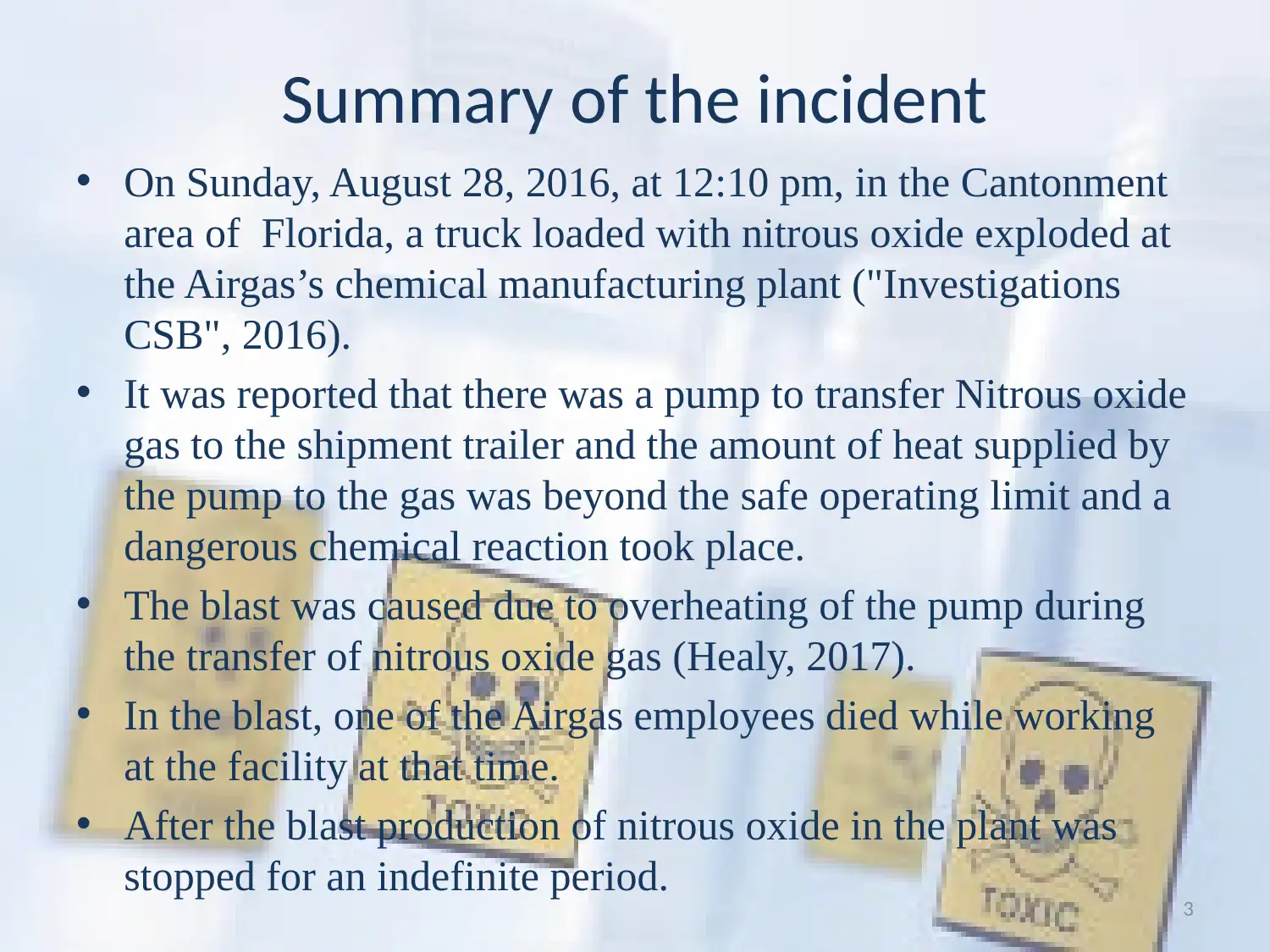
3
Summary of the incident
• On Sunday, August 28, 2016, at 12:10 pm, in the Cantonment
area of Florida, a truck loaded with nitrous oxide exploded at
the Airgas’s chemical manufacturing plant ("Investigations
CSB", 2016).
• It was reported that there was a pump to transfer Nitrous oxide
gas to the shipment trailer and the amount of heat supplied by
the pump to the gas was beyond the safe operating limit and a
dangerous chemical reaction took place.
• The blast was caused due to overheating of the pump during
the transfer of nitrous oxide gas (Healy, 2017).
• In the blast, one of the Airgas employees died while working
at the facility at that time.
• After the blast production of nitrous oxide in the plant was
stopped for an indefinite period.
Summary of the incident
• On Sunday, August 28, 2016, at 12:10 pm, in the Cantonment
area of Florida, a truck loaded with nitrous oxide exploded at
the Airgas’s chemical manufacturing plant ("Investigations
CSB", 2016).
• It was reported that there was a pump to transfer Nitrous oxide
gas to the shipment trailer and the amount of heat supplied by
the pump to the gas was beyond the safe operating limit and a
dangerous chemical reaction took place.
• The blast was caused due to overheating of the pump during
the transfer of nitrous oxide gas (Healy, 2017).
• In the blast, one of the Airgas employees died while working
at the facility at that time.
• After the blast production of nitrous oxide in the plant was
stopped for an indefinite period.
⊘ This is a preview!⊘
Do you want full access?
Subscribe today to unlock all pages.

Trusted by 1+ million students worldwide
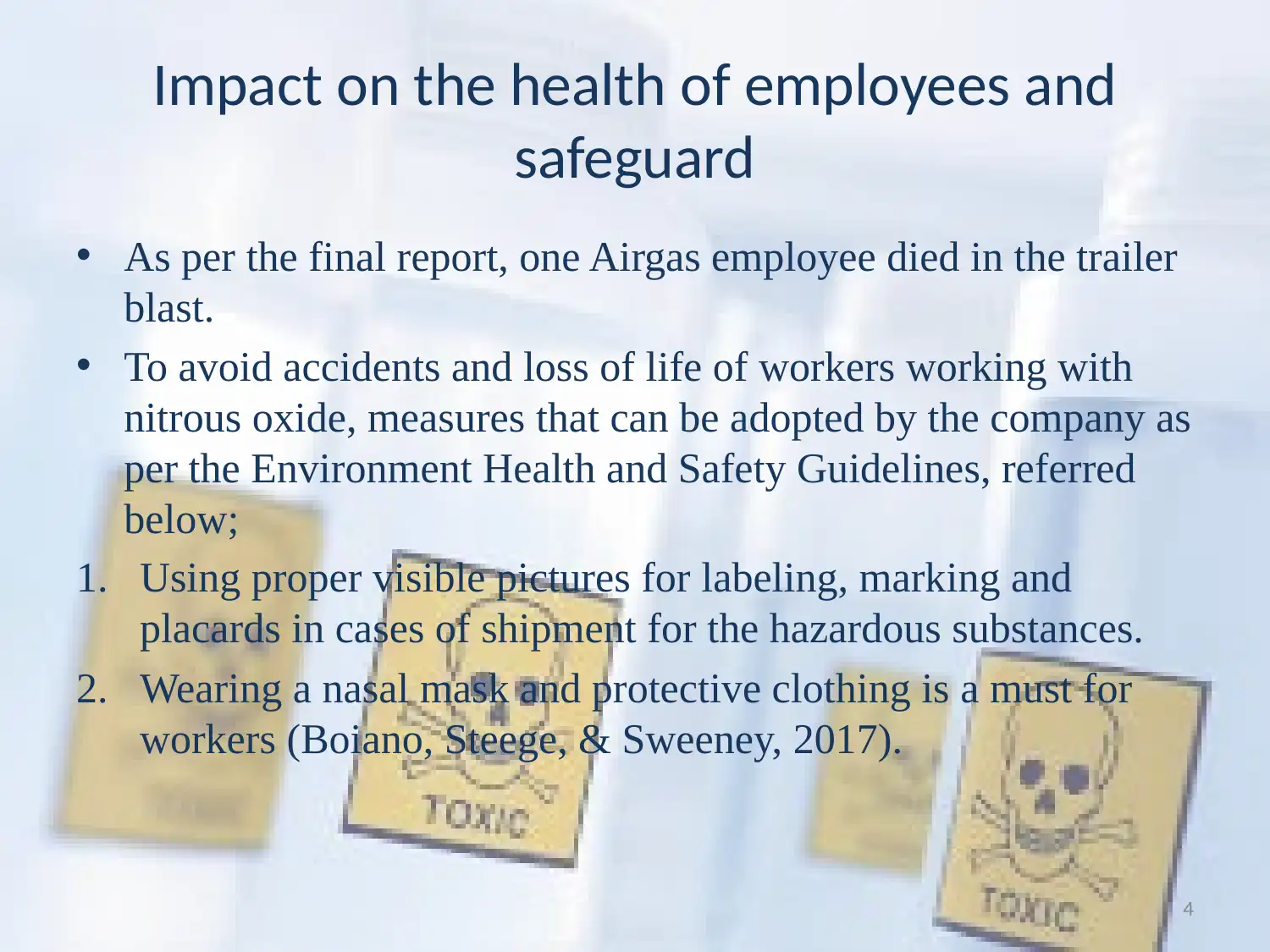
4
Impact on the health of employees and
safeguard
• As per the final report, one Airgas employee died in the trailer
blast.
• To avoid accidents and loss of life of workers working with
nitrous oxide, measures that can be adopted by the company as
per the Environment Health and Safety Guidelines, referred
below;
1. Using proper visible pictures for labeling, marking and
placards in cases of shipment for the hazardous substances.
2. Wearing a nasal mask and protective clothing is a must for
workers (Boiano, Steege, & Sweeney, 2017).
Impact on the health of employees and
safeguard
• As per the final report, one Airgas employee died in the trailer
blast.
• To avoid accidents and loss of life of workers working with
nitrous oxide, measures that can be adopted by the company as
per the Environment Health and Safety Guidelines, referred
below;
1. Using proper visible pictures for labeling, marking and
placards in cases of shipment for the hazardous substances.
2. Wearing a nasal mask and protective clothing is a must for
workers (Boiano, Steege, & Sweeney, 2017).
Paraphrase This Document
Need a fresh take? Get an instant paraphrase of this document with our AI Paraphraser
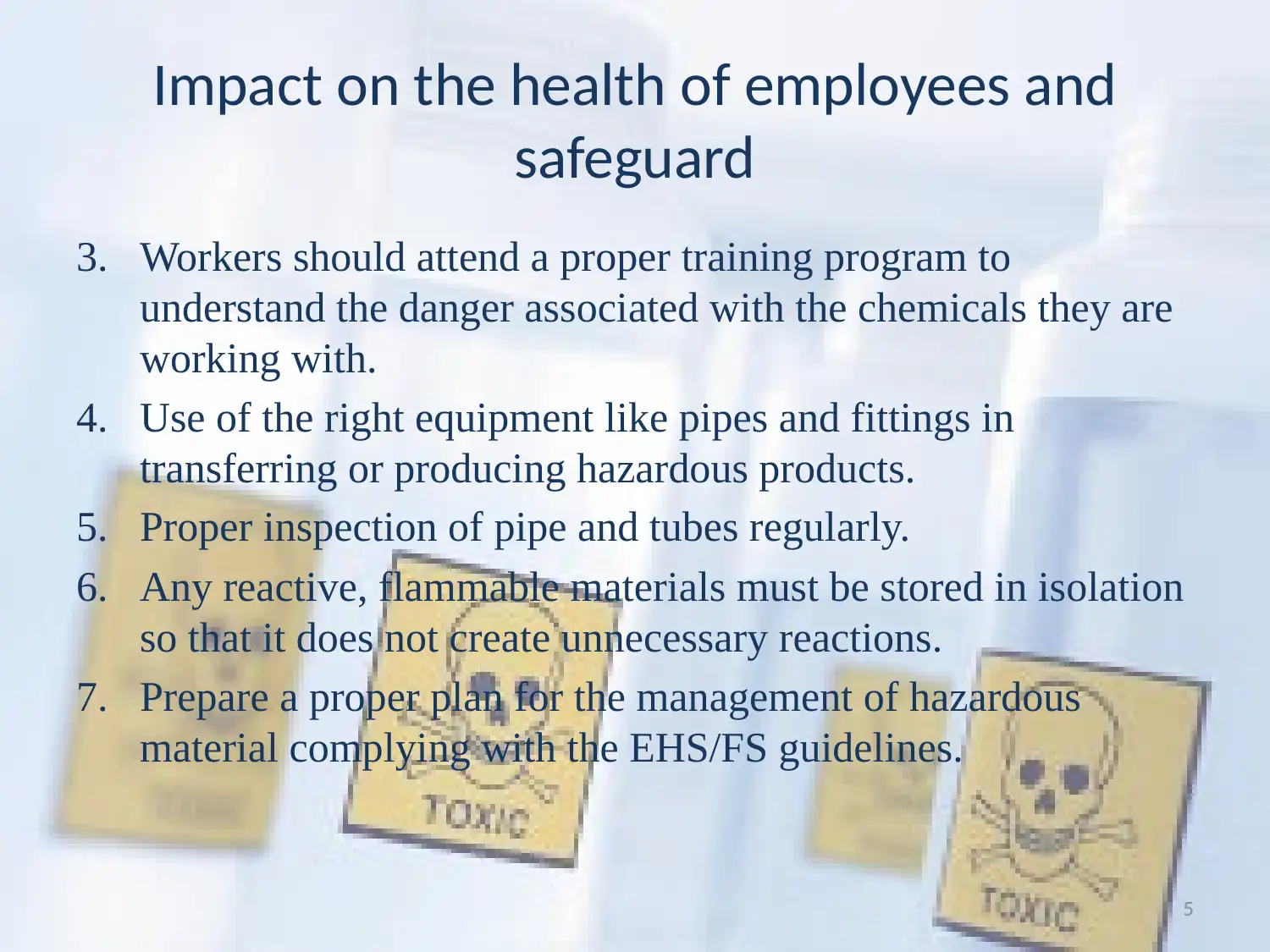
5
Impact on the health of employees and
safeguard
3. Workers should attend a proper training program to
understand the danger associated with the chemicals they are
working with.
4. Use of the right equipment like pipes and fittings in
transferring or producing hazardous products.
5. Proper inspection of pipe and tubes regularly.
6. Any reactive, flammable materials must be stored in isolation
so that it does not create unnecessary reactions.
7. Prepare a proper plan for the management of hazardous
material complying with the EHS/FS guidelines.
Impact on the health of employees and
safeguard
3. Workers should attend a proper training program to
understand the danger associated with the chemicals they are
working with.
4. Use of the right equipment like pipes and fittings in
transferring or producing hazardous products.
5. Proper inspection of pipe and tubes regularly.
6. Any reactive, flammable materials must be stored in isolation
so that it does not create unnecessary reactions.
7. Prepare a proper plan for the management of hazardous
material complying with the EHS/FS guidelines.
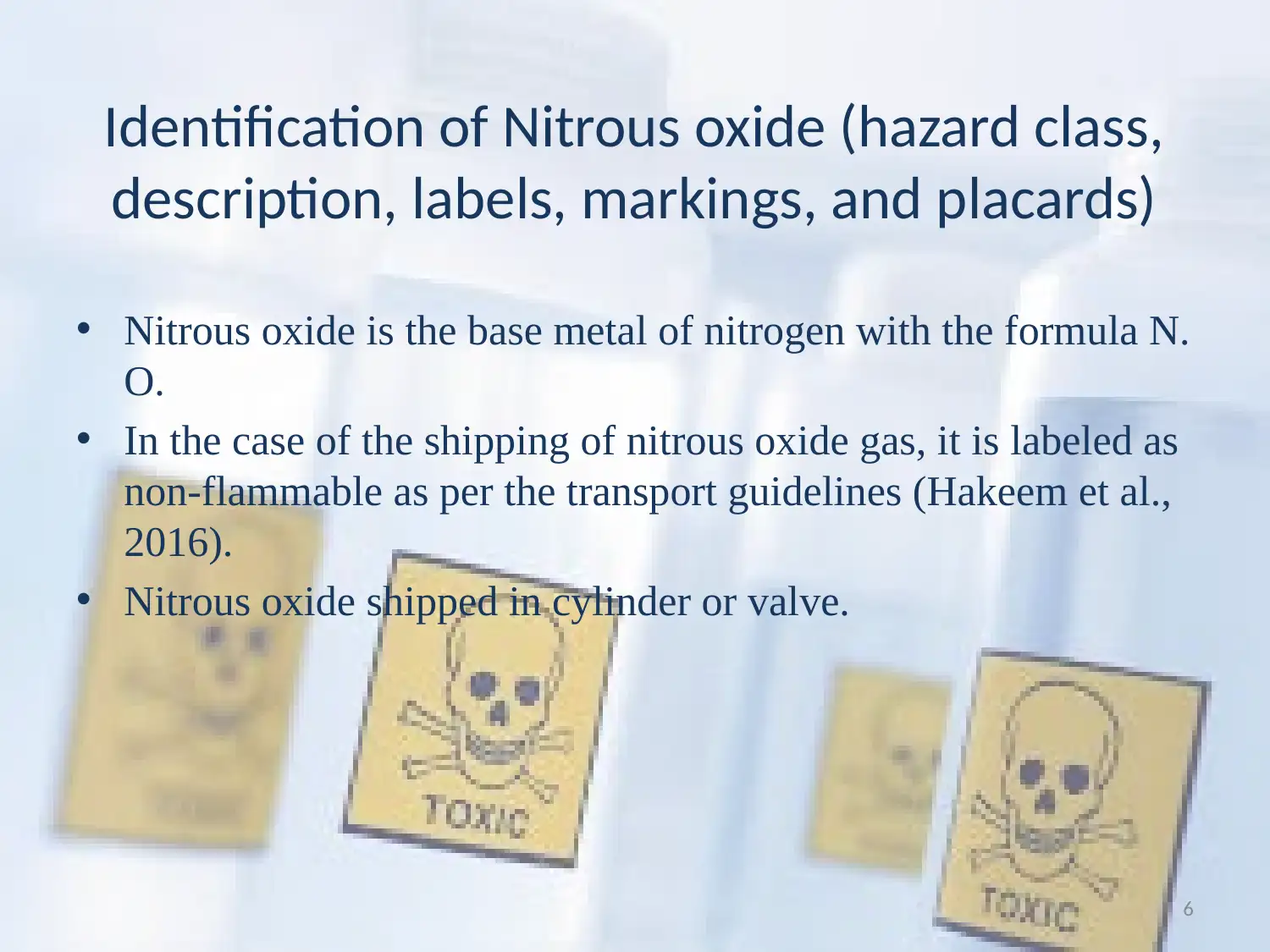
6
Identification of Nitrous oxide (hazard class,
description, labels, markings, and placards)
• Nitrous oxide is the base metal of nitrogen with the formula N.
O.
• In the case of the shipping of nitrous oxide gas, it is labeled as
non-flammable as per the transport guidelines (Hakeem et al.,
2016).
• Nitrous oxide shipped in cylinder or valve.
Identification of Nitrous oxide (hazard class,
description, labels, markings, and placards)
• Nitrous oxide is the base metal of nitrogen with the formula N.
O.
• In the case of the shipping of nitrous oxide gas, it is labeled as
non-flammable as per the transport guidelines (Hakeem et al.,
2016).
• Nitrous oxide shipped in cylinder or valve.
⊘ This is a preview!⊘
Do you want full access?
Subscribe today to unlock all pages.

Trusted by 1+ million students worldwide
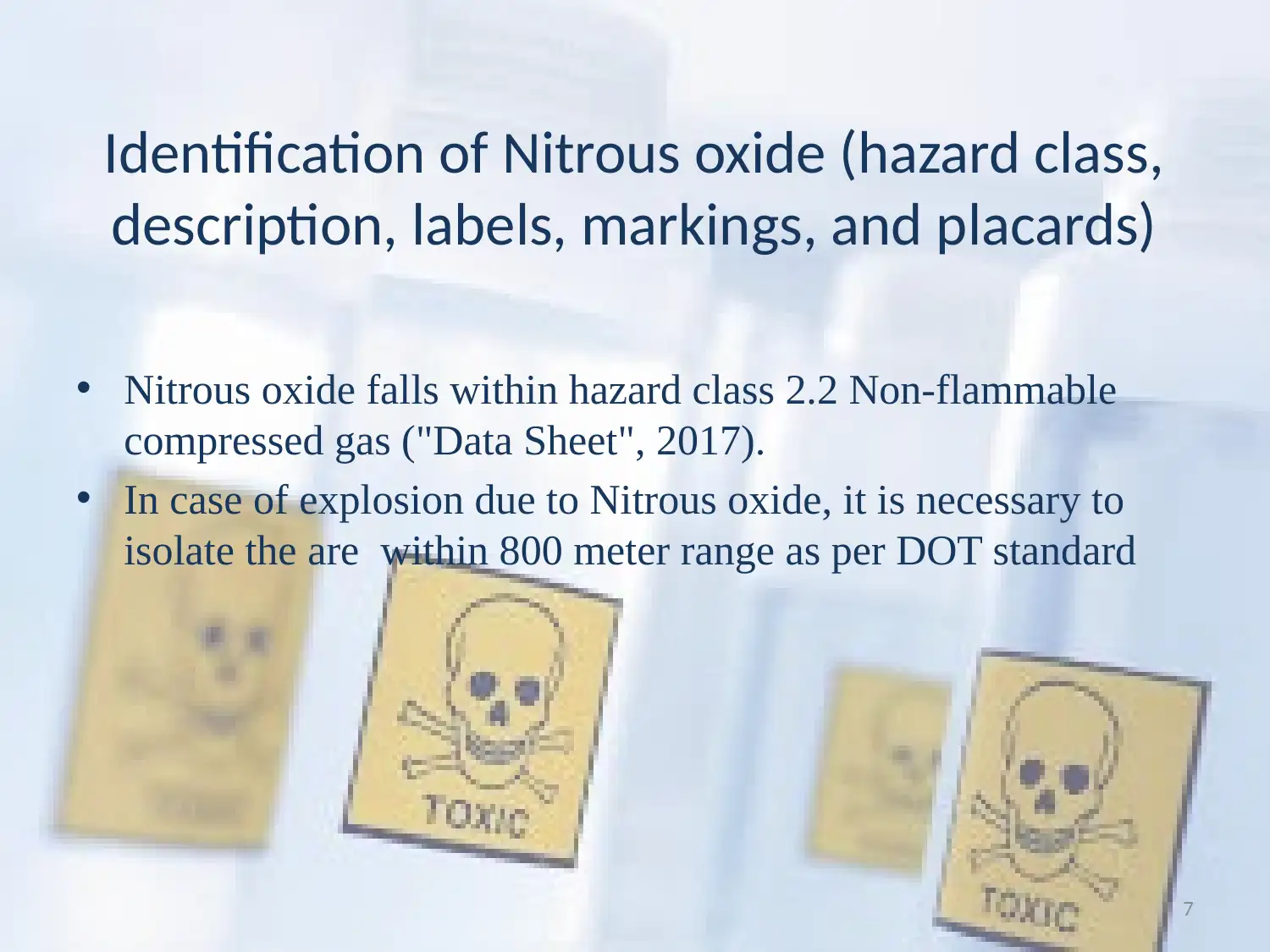
7
Identification of Nitrous oxide (hazard class,
description, labels, markings, and placards)
• Nitrous oxide falls within hazard class 2.2 Non-flammable
compressed gas ("Data Sheet", 2017).
• In case of explosion due to Nitrous oxide, it is necessary to
isolate the are within 800 meter range as per DOT standard
Identification of Nitrous oxide (hazard class,
description, labels, markings, and placards)
• Nitrous oxide falls within hazard class 2.2 Non-flammable
compressed gas ("Data Sheet", 2017).
• In case of explosion due to Nitrous oxide, it is necessary to
isolate the are within 800 meter range as per DOT standard
Paraphrase This Document
Need a fresh take? Get an instant paraphrase of this document with our AI Paraphraser
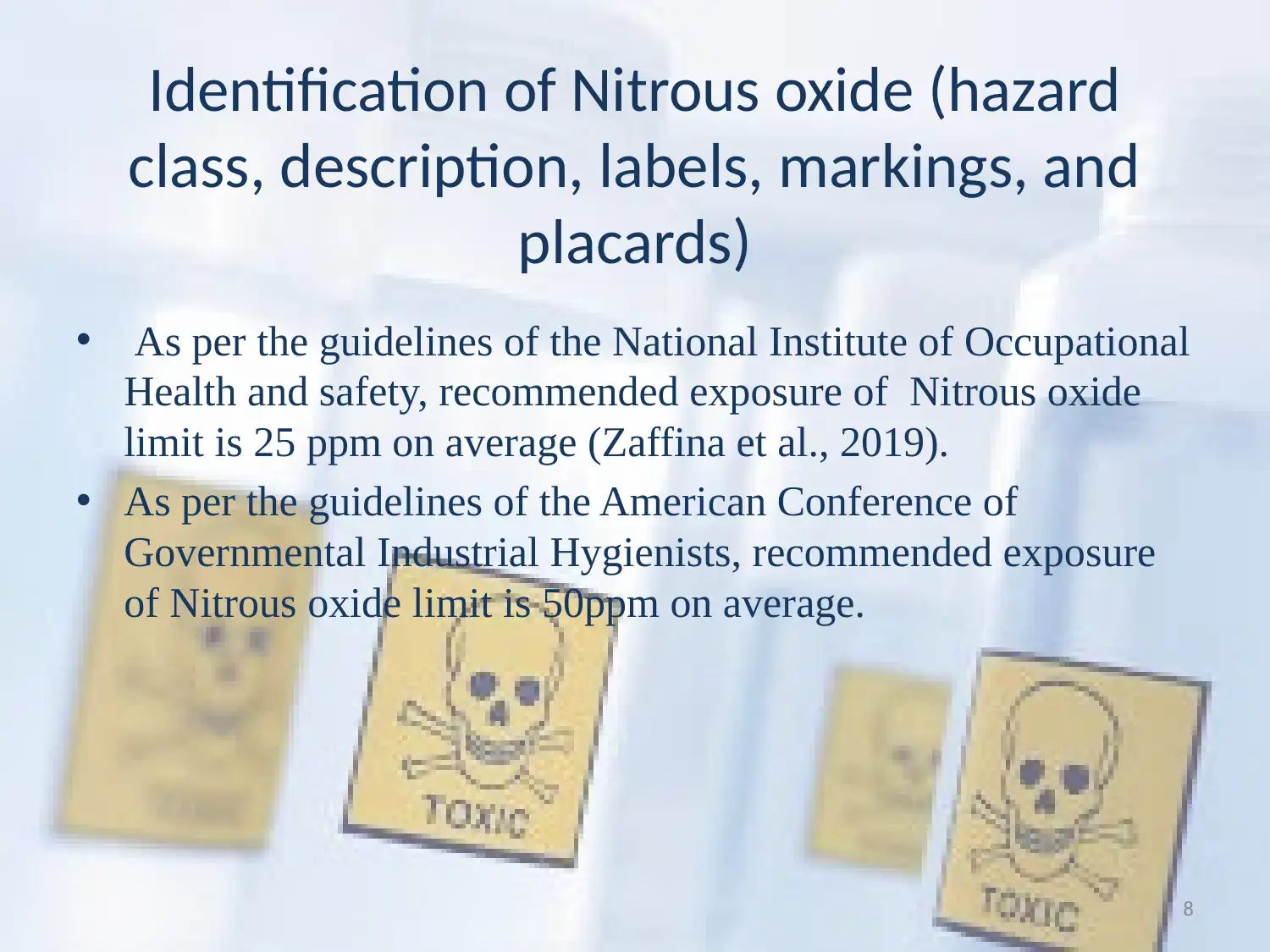
8
Identification of Nitrous oxide (hazard
class, description, labels, markings, and
placards)
• As per the guidelines of the National Institute of Occupational
Health and safety, recommended exposure of Nitrous oxide
limit is 25 ppm on average (Zaffina et al., 2019).
• As per the guidelines of the American Conference of
Governmental Industrial Hygienists, recommended exposure
of Nitrous oxide limit is 50ppm on average.
Identification of Nitrous oxide (hazard
class, description, labels, markings, and
placards)
• As per the guidelines of the National Institute of Occupational
Health and safety, recommended exposure of Nitrous oxide
limit is 25 ppm on average (Zaffina et al., 2019).
• As per the guidelines of the American Conference of
Governmental Industrial Hygienists, recommended exposure
of Nitrous oxide limit is 50ppm on average.
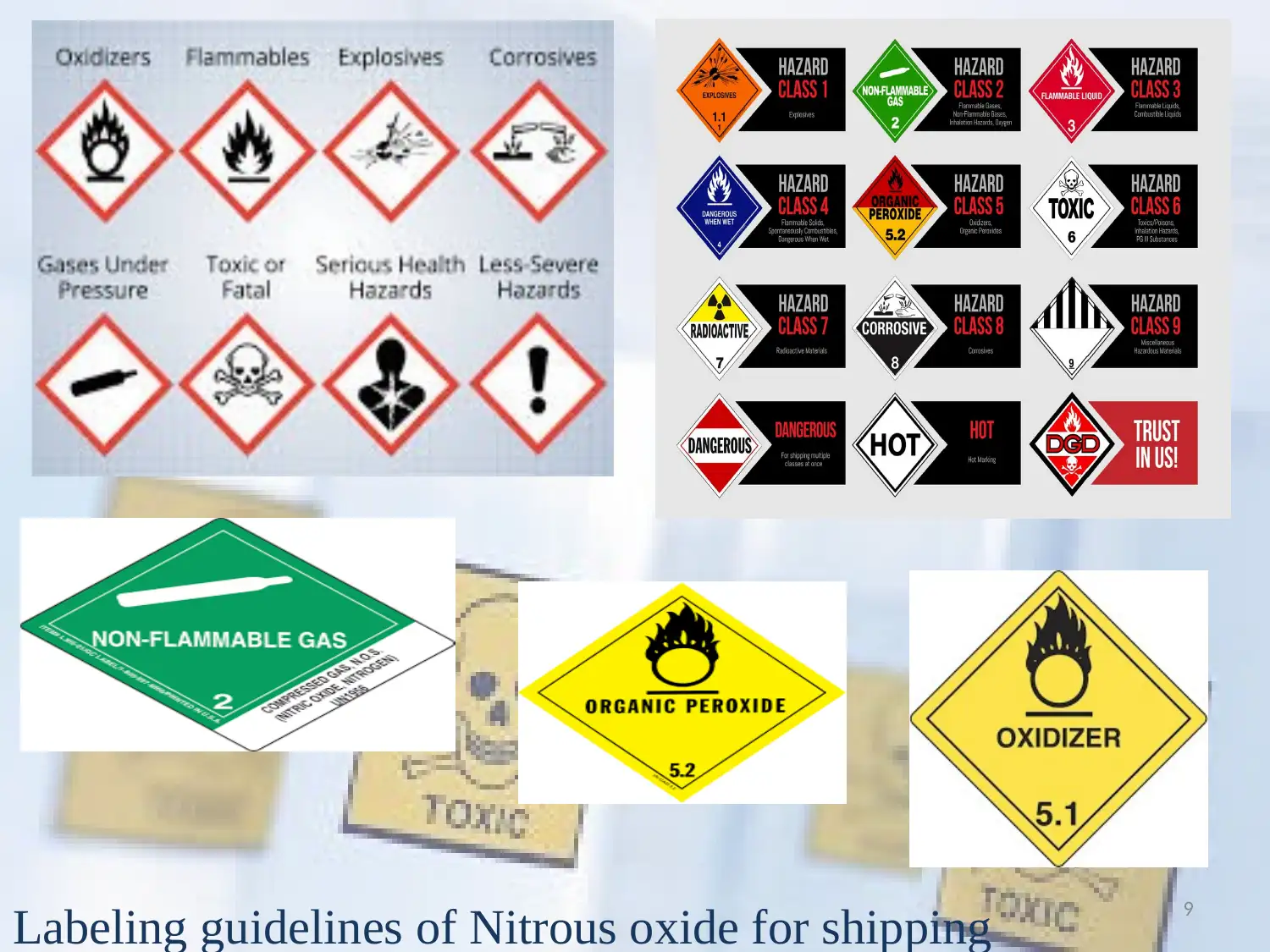
9
Labeling guidelines of Nitrous oxide for shipping
Labeling guidelines of Nitrous oxide for shipping
⊘ This is a preview!⊘
Do you want full access?
Subscribe today to unlock all pages.

Trusted by 1+ million students worldwide
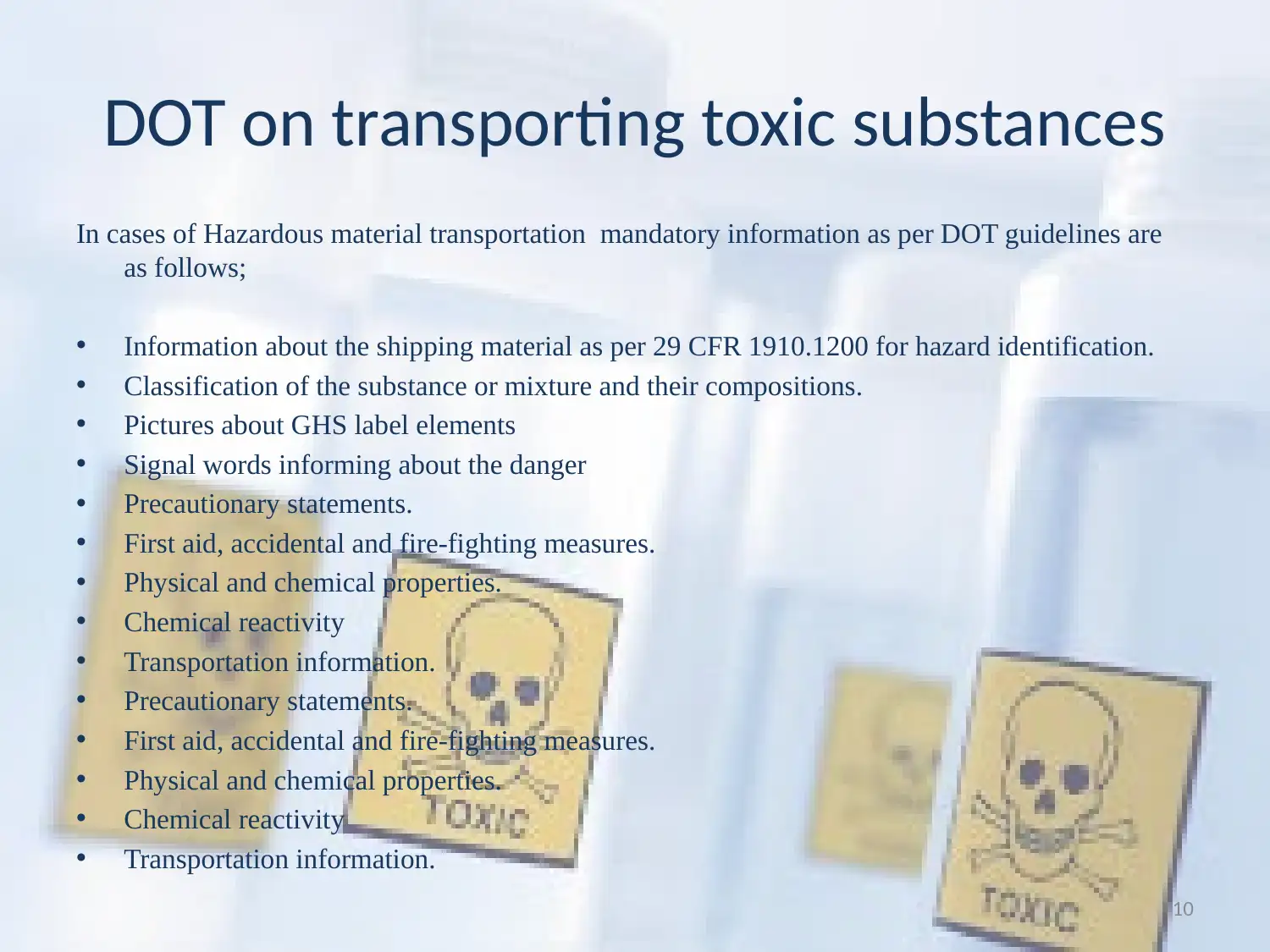
10
DOT on transporting toxic substances
In cases of Hazardous material transportation mandatory information as per DOT guidelines are
as follows;
• Information about the shipping material as per 29 CFR 1910.1200 for hazard identification.
• Classification of the substance or mixture and their compositions.
• Pictures about GHS label elements
• Signal words informing about the danger
• Precautionary statements.
• First aid, accidental and fire-fighting measures.
• Physical and chemical properties.
• Chemical reactivity
• Transportation information.
• Precautionary statements.
• First aid, accidental and fire-fighting measures.
• Physical and chemical properties.
• Chemical reactivity
• Transportation information.
DOT on transporting toxic substances
In cases of Hazardous material transportation mandatory information as per DOT guidelines are
as follows;
• Information about the shipping material as per 29 CFR 1910.1200 for hazard identification.
• Classification of the substance or mixture and their compositions.
• Pictures about GHS label elements
• Signal words informing about the danger
• Precautionary statements.
• First aid, accidental and fire-fighting measures.
• Physical and chemical properties.
• Chemical reactivity
• Transportation information.
• Precautionary statements.
• First aid, accidental and fire-fighting measures.
• Physical and chemical properties.
• Chemical reactivity
• Transportation information.
Paraphrase This Document
Need a fresh take? Get an instant paraphrase of this document with our AI Paraphraser
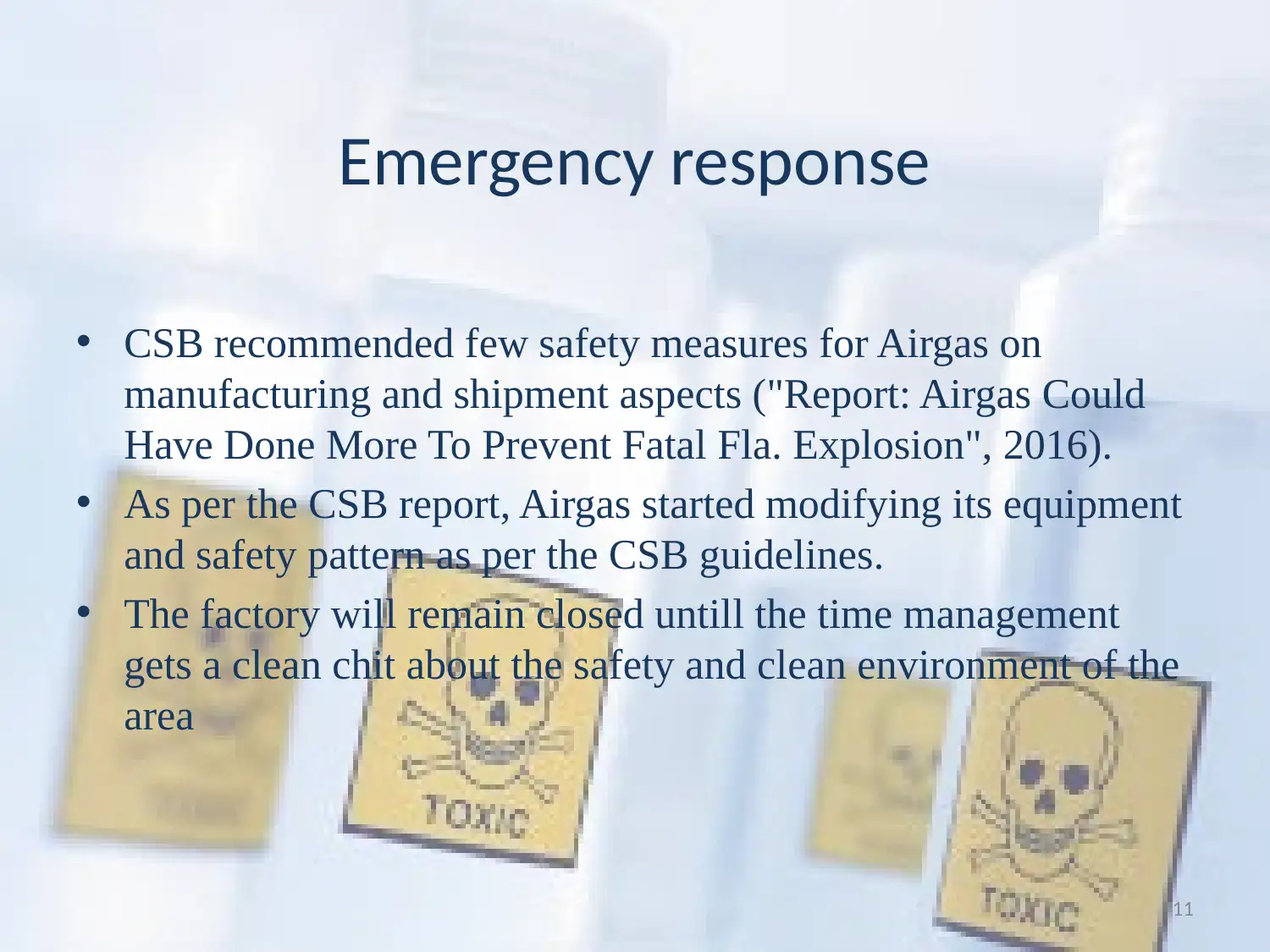
11
Emergency response
• CSB recommended few safety measures for Airgas on
manufacturing and shipment aspects ("Report: Airgas Could
Have Done More To Prevent Fatal Fla. Explosion", 2016).
• As per the CSB report, Airgas started modifying its equipment
and safety pattern as per the CSB guidelines.
• The factory will remain closed untill the time management
gets a clean chit about the safety and clean environment of the
area
Emergency response
• CSB recommended few safety measures for Airgas on
manufacturing and shipment aspects ("Report: Airgas Could
Have Done More To Prevent Fatal Fla. Explosion", 2016).
• As per the CSB report, Airgas started modifying its equipment
and safety pattern as per the CSB guidelines.
• The factory will remain closed untill the time management
gets a clean chit about the safety and clean environment of the
area
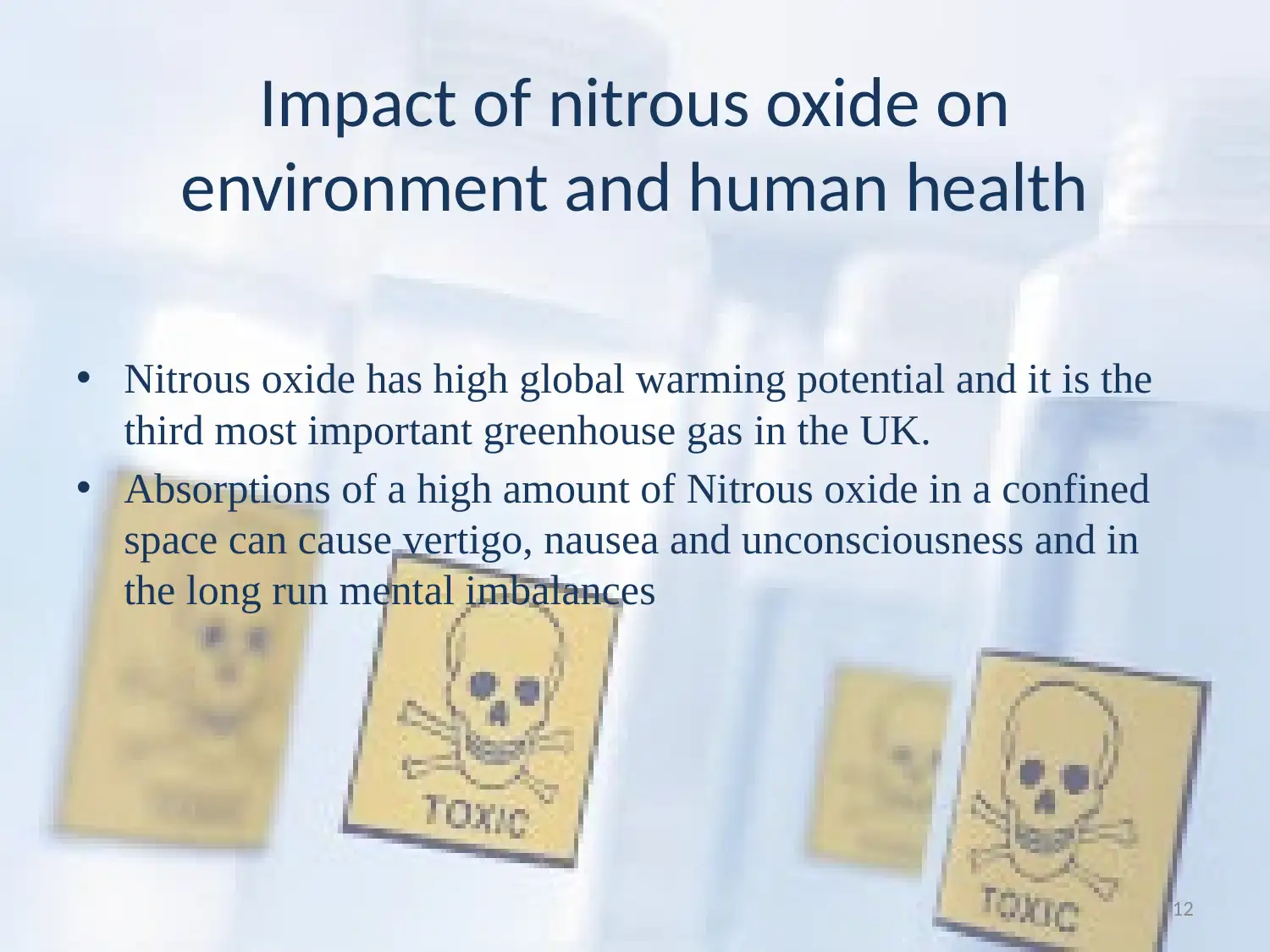
12
Impact of nitrous oxide on
environment and human health
• Nitrous oxide has high global warming potential and it is the
third most important greenhouse gas in the UK.
• Absorptions of a high amount of Nitrous oxide in a confined
space can cause vertigo, nausea and unconsciousness and in
the long run mental imbalances
Impact of nitrous oxide on
environment and human health
• Nitrous oxide has high global warming potential and it is the
third most important greenhouse gas in the UK.
• Absorptions of a high amount of Nitrous oxide in a confined
space can cause vertigo, nausea and unconsciousness and in
the long run mental imbalances
⊘ This is a preview!⊘
Do you want full access?
Subscribe today to unlock all pages.

Trusted by 1+ million students worldwide
1 out of 15
Your All-in-One AI-Powered Toolkit for Academic Success.
+13062052269
info@desklib.com
Available 24*7 on WhatsApp / Email
![[object Object]](/_next/static/media/star-bottom.7253800d.svg)
Unlock your academic potential
Copyright © 2020–2025 A2Z Services. All Rights Reserved. Developed and managed by ZUCOL.